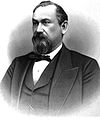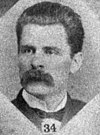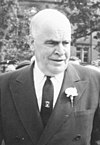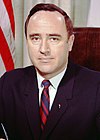Lieutenant Governor of North Carolina
| Lieutenant Governor of North Carolina | |
|---|---|
 | |
| Style |
|
| Member of |
|
| Seat | Raleigh, North Carolina |
| Term length | Four years, renewable once consecutively |
| Constituting instrument | North Carolina Constitution of 1868 |
| Inaugural holder | Tod R. Caldwell |
| Formation | 1868 |
| Salary | US$124,676 per year (2013)[1] |
| Website | Official website |
The lieutenant governor of North Carolina is the second highest elected official in the U.S. state of North Carolina and is the only elected official to have powers in both the legislative and executive branches of state government. The current lieutenant governor is Mark Robinson, a Republican.
As of 2008, the administrative offices of the lieutenant governor are located in the historic Hawkins-Hartness House on N. Blount Street in Raleigh's Government District. The lieutenant governor also maintains an office at the nearby North Carolina State Legislative Building. At one time, the lieutenant governor had an office in the North Carolina State Capitol.[2]
Duties and powers[]
The office of lieutenant governor was created by the North Carolina Constitution of 1868. Just as the vice president of the United States presides (albeit rarely) over the United States Senate, the lieutenant governor's primary responsibility is to preside over the North Carolina Senate; until 1970, this was the lieutenant governor's only major responsibility, and the position was only part-time. The position is now a full-time job.
By virtue of the office (Ex officio), the lieutenant governor is a member of the Council of State, the North Carolina Board of Education, the North Carolina Capital Planning Commission, and the North Carolina Board of Community Colleges, and serves as the Chairman of the eLearning Commission.[3]
From 1868 through 1977, the lieutenant governor, like the governor of North Carolina, was limited to a single four-year term. In 1977, the North Carolina Constitution was amended to allow both the governor and the lieutenant governor to serve two consecutive terms.[4]
Succession to office of governor[]
The lieutenant governor is the first official in line to succeed the governor of North Carolina, should that office be vacated. This has occurred five times in the history of the office; four of the first six lieutenant governors were promoted upon the death, impeachment, or resignation of the previously sitting governor.
Lieutenant governors have often run for governor, but few have been successful. Jim Hunt, elected governor in 1976, and Beverly Perdue, elected governor in 2008, are the two most recent exceptions.[5]
The lieutenant governor is elected on a separate ballot from the governor; therefore, it is theoretically possible that the governor and lieutenant governor may be of different political party affiliations. This has happened three times in North Carolina since the 1977 constitutional amendment, once from 1985 to 1989, 2017 to 2021, and during the current 2021 to 2025 term.
List of lieutenant governors[]
- Parties
Democratic (29) Republican (6)
| # | Portrait | Lt. Governor | Term of office | Political party | Governor(s) |
|---|---|---|---|---|---|
| 1 |  |
Tod R. Caldwell[a] | 1868–1870 | Republican | William W. Holden (R) |
| Office vacant 1870–1873 | |||||
| 2 |  |
Curtis H. Brogden | 1873–1874 | Republican | Tod R. Caldwell (R) |
| Office vacant 1874–1877 | |||||
| 3 |  |
Thomas J. Jarvis | 1877–1879 | Democratic | Zebulon B. Vance (D) |
| Office vacant 1879–1881 | |||||
| 4 |  |
James L. Robinson[b] | 1881–1885 | Democratic | Thomas J. Jarvis (D) |
| 5 |  |
Charles M. Stedman | 1885–1889 | Democratic | Alfred Moore Scales (D) |
| 6 |  |
Thomas M. Holt | 1889–1891 | Democratic | Daniel Gould Fowle (D) |
| Office vacant 1891–1893 | |||||
| 7 |  |
Rufus A. Doughton | 1893–1897 | Democratic | Elias Carr (D) |
| 8 |  |
Charles A. Reynolds | 1897–1901 | Republican | Daniel Lindsay Russell (R) |
| 9 |  |
Wilfred D. Turner | 1901–1905 | Democratic | Charles Brantley Aycock (D) |
| 10 |  |
Francis D. Winston | 1905–1909 | Democratic | Robert Broadnax Glenn (D) |
| 11 |  |
William C. Newland | 1909–1913 | Democratic | William Walton Kitchin (D) |
| 12 |  |
Elijah L. Daughtridge | 1913–1917 | Democratic | Locke Craig (D) |
| 13 |  |
Oliver Max Gardner | 1917–1921 | Democratic | Thomas Walter Bickett (D) |
| 14 |  |
William B. Cooper | 1921–1925 | Democratic | Cameron A. Morrison (D) |
| 15 |  |
Jacob E. Long | 1925–1929 | Democratic | Angus Wilton McLean (D) |
| 16 |  |
Richard T. Fountain | 1929–1933 | Democratic | Oliver Max Gardner (D) |
| 17 |  |
Alexander H. Graham | 1933–1937 | Democratic | John C. B. Ehringhaus (D) |
| 18 |  |
Wilkins P. Horton | 1937–1941 | Democratic | Clyde R. Hoey (D) |
| 19 |  |
Reginald L. Harris | 1941–1945 | Democratic | J. Melville Broughton (D) |
| 20 |  |
Lynton Y. Ballentine | 1945–1949 | Democratic | R. Gregg Cherry (D) |
| 21 |  |
Hoyt Patrick Taylor | 1949–1953 | Democratic | W. Kerr Scott (D) |
| 22 |  |
Luther H. Hodges | 1953–1954 | Democratic | William B. Umstead (D) |
| Office vacant 1954–1957 | |||||
| 23 |  |
Luther E. Barnhardt | 1957–1961 | Democratic | Luther H. Hodges (D) |
| 24 |  |
Harvey Cloyd Philpott[c] | 1961 | Democratic | Terry Sanford (D) |
| Office vacant 1961–1965 | |||||
| 25 |  |
Robert W. Scott | 1965–1969 | Democratic | Dan K. Moore (D) |
| 26 |  |
Hoyt Patrick Taylor, Jr. | 1969–1973 | Democratic | Robert W. Scott (D) |
| 27 |  |
Jim Hunt | 1973–1977 | Democratic | James Holshouser (R) |
| 28 |  |
James C. Green[d] | 1977–1985 | Democratic | Jim Hunt (D) |
| 29 |  |
Robert B. Jordan | 1985–1989 | Democratic | James G. Martin (R) |
| 30 |  |
Jim Gardner[e] | 1989–1993 | Republican | |
| 31 |  |
Dennis Wicker | 1993–2001 | Democratic | Jim Hunt (D) |
| 32 |  |
Bev Perdue[f] | 2001–2009 | Democratic | Mike Easley (D) |
| 33 |  |
Walter Dalton | 2009–2013 | Democratic | Bev Perdue (D) |
| 34 |  |
Dan Forest | 2013–2021 | Republican | Pat McCrory (R) (2013–2017) |
| Roy Cooper (D) (2017–2021) | |||||
| 35 |  |
Mark Robinson[g] | 2021–present | Republican | Roy Cooper (D) |
- Notes
- ^ Became Governor on December 20, 1870.
- ^ Robinson is often referred to as "acting Lieutenant Governor" from 1879 through 1881, because, as President Pro Tempore of the Senate at the time that Jarvis succeeded to the governorship, he became President of the Senate, putting him next in line to succeed the governor. However, technically, there is no such office as "acting" lieutenant governor, meaning that the office was vacant, just as it had been in periods such as 1874-1877. Robinson was elected lieutenant governor in his own right in 1880.
- ^ Died in office.
- ^ First Lt. Governor to serve two terms.
- ^ First Republican elected since Reynolds in 1896.
- ^ First female Lt. Governor.
- ^ First African American Lt. Governor.
See also[]
North Carolina Lieutenant Governor Elections: 1996, 2000, 2004, 2008, 2012, 2016, 2020
References[]
- ^ "CSG Releases 2013 Governor Salaries". The Council of State Governments. June 25, 2013. Retrieved November 23, 2014.
- ^ News & Observer: Homeless lt. governors, next on Oprah? Archived 2009-02-28 at the Wayback Machine
- ^ eLearningNC
- ^ NC Government Records Branch
- ^ News & Observer: A curse on lieutenant governors? Archived 2008-10-23 at the Wayback Machine
External links[]
- Lieutenant Governors of North Carolina
- State constitutional officers of North Carolina
- North Carolina Council of State

